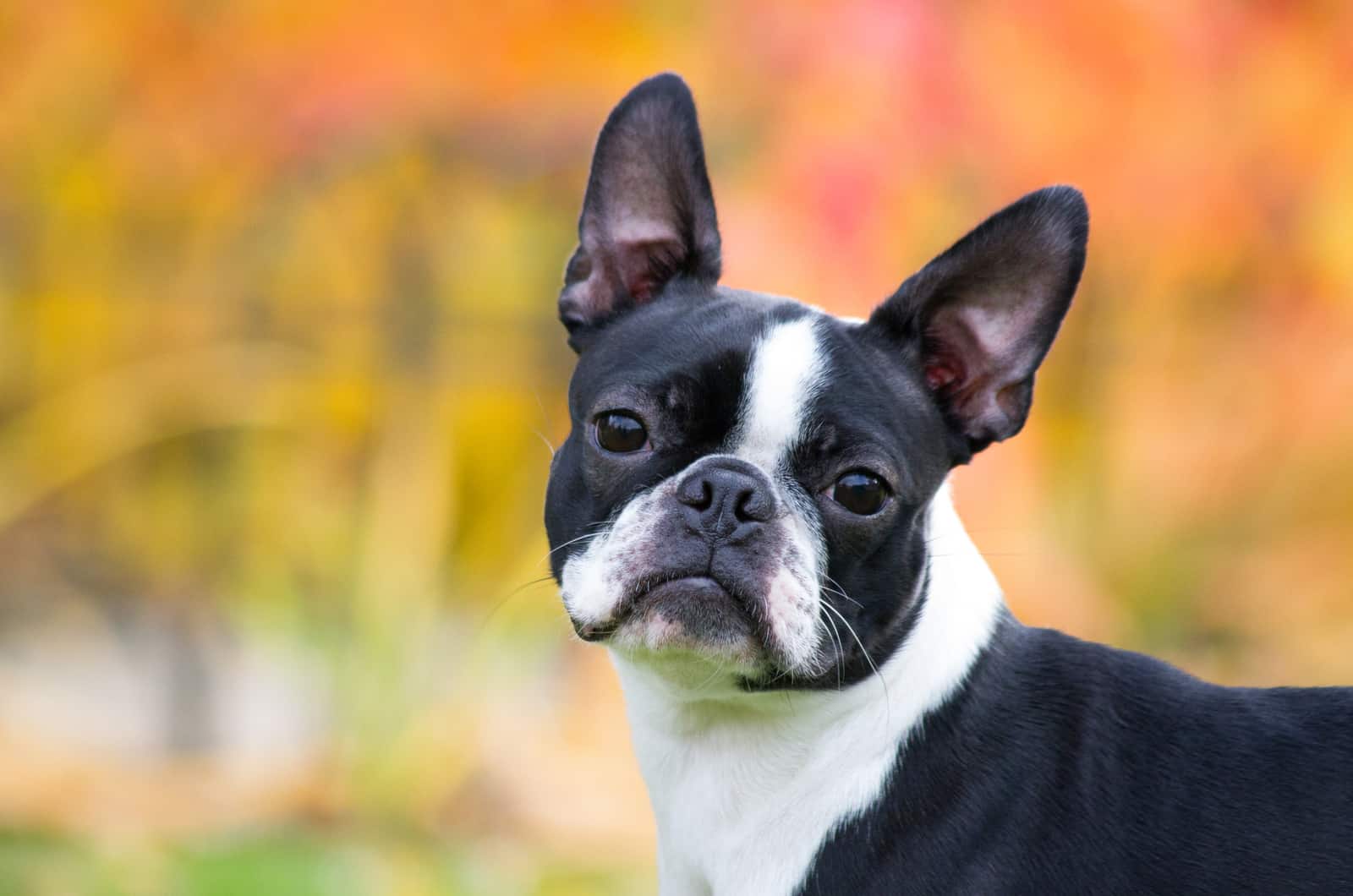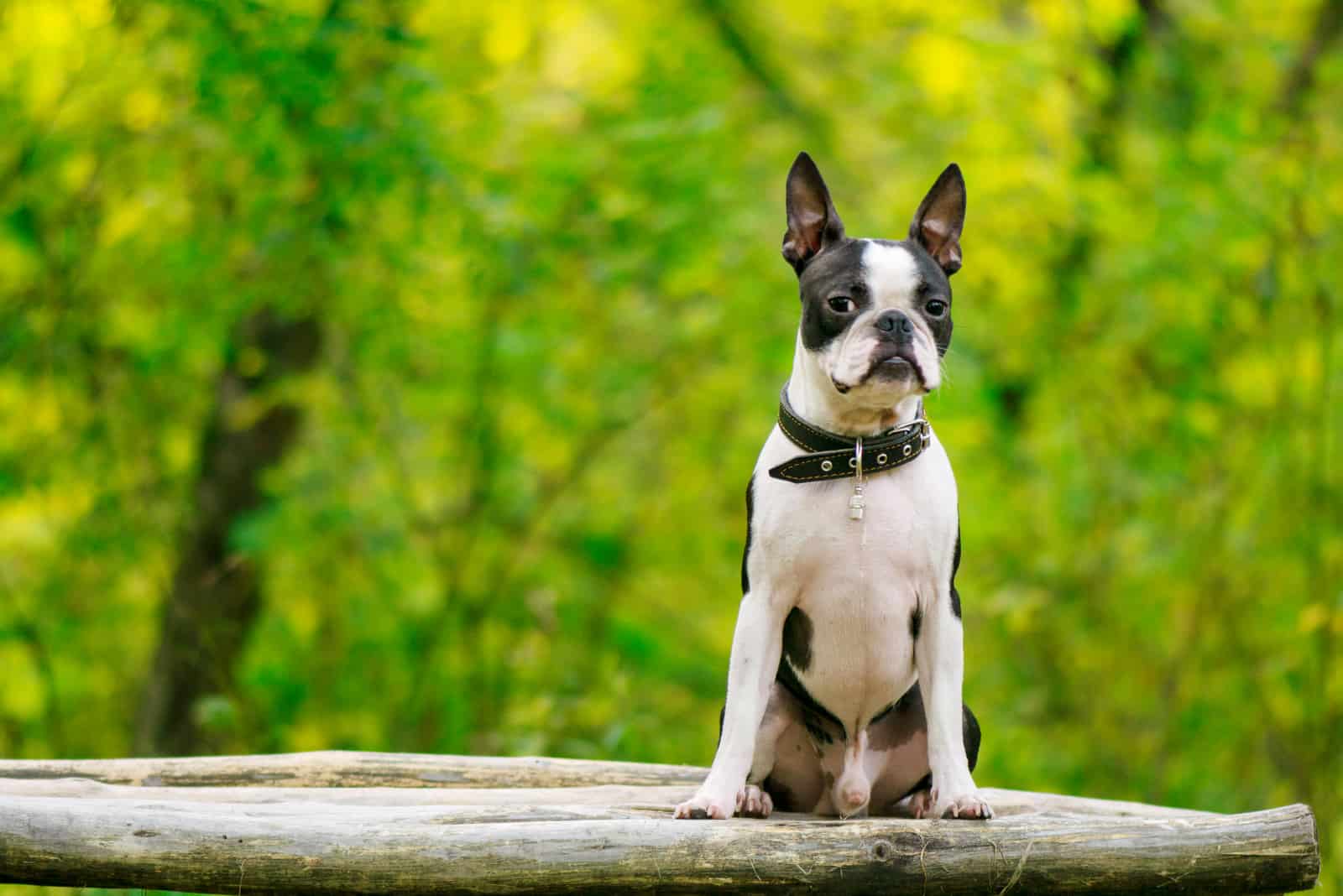The Boston Terrier is a dog bred to be the perfect mixture of a ratting dog and a fighting dog that would win in the pits – something like a mixture of a Bulldog and a Terrier breed. However, what the breeders ended up with is something entirely different.
The Boston Terrier ended up being one of the kindest, most charming dogs you can imagine. This even earned him the nickname of The American Gentleman.
You can easily recognize this dog breed by white markings on its muzzle, along with a white chest, tummy area, front legs, and hind paws, and a brindle or a black base coat.
One thing that is challenging to differentiate, though, is which dog you’re dealing with when it comes to a male vs a female Boston Terrier.
In short, no matter which gender you decide on, you can rest assured you’re dealing with a kind family dog that is the perfect pet for every first-time dog owner. However, there are some striking differences between the two that not many people are aware of, especially when it comes to their personalities.
If you want to get a playful Boston Terrier that is easy to potty train, but can be borderline clingy, then you should take a male. However, if you prefer a more independent (and more intelligent!) dog, then a female dog might be the better choice.
But, we’re certain these two sentences aren’t enough for curious people interested in learning more about male vs female Boston Terriers. As such, we’ve decided to help you out on making the important decision as to which one you should choose.
While the choice of a male vs a female Boston Terrier seems simple, there is some crucial information that aspiring dog owners should know.
Let’s get into detail!
Difference Between Male And Female Boston Terriers

Before we start, here is a short overview of male vs female Boston Terriers and their differences:
| Height | Weight | Price | Lifespan | Build | Temperament | |
|---|---|---|---|---|---|---|
| Male | 15-17 ins | 10-25 lbs | $1,500-$2,000 | 13-15 years | Bulky, lots of muscle | Friendly, playful, clingy |
| Female | 9-15 ins | 9-20 lbs | $1,200-$1,800 | 13-15 years | Lean, less muscle | Friendly, independent, intelligent |
Now that we’ve got some basic differences out of the way, here is what you need to know when it comes to male vs female Boston Terriers:
Male Vs Female Boston Terrier Size
The size difference is the first thing that dog owners look at when they want to find out whether a dog is a male or a female.
Most physical characteristics are the same in both males and females. Boston Terriers are small dogs, with brachycephalic heads and erect but somewhat floppy ears. Their heads look a bit like a Pugs’, but with a bit longer muzzle.
They have a distinguishable tuxedo pattern, and it seems as if the bottom part of their body is white, while the rest is in some color – usually black or brindle. Their eyes are large, round, and dark, and they seem to always have curious looks on their faces. Their appearance makes some people confuse them with English Terriers.
However, some differences between the genders still exist.
Male Boston Terriers
Just like in most other breeds, male dogs are slightly taller and heavier than females. This difference isn’t overly significant, but it still can be noticed. Usually, males are about two inches taller than females. As such, they can reach a height of 17 inches, according to the American Kennel Club’s (AKC) breed standard.
At the same time, they are slightly heavier compared to their female counterparts. Most adult males weigh anywhere between 10 and 25 pounds. This is because they are bulkier and more muscular than females.
This body type is what gives male Boston Terriers the strength and high energy levels to play all day long, and they certainly look the part!
Female Boston Terriers
Females are smaller and fairly lighter than male Boston Terriers. They rarely grow to be taller than 15 inches.
When it comes to weight, they should weigh anywhere between 9 and 20 lbs. However, they are prone to obesity, especially spayed females, and it’s not uncommon for them to weigh more. Still, this isn’t healthy.
As such, giving them high-quality dog food is very important, as it can prevent many health problems that are associated with obesity. The Boston Terrier feeding chart might be a useful tool for you to determine the exact nutritional needs of your dog.
Allowing these pups to become overweight is also very dangerous for breeders, as it can ruin the female’s chances of giving a successful birth.
Their pelvic structure is too small to be able to deliver puppies if there is too much fat on these pups’ bodies.
Male Vs Female Boston Terrier; Temperamental Differences

No matter their gender, Boston Terriers are friendly and playful. They are also very social, and they can get along with both humans and other pets alike. Just make sure to monitor them around kids, as they are very active and might scare a small child with their high energy levels.
These dogs are quiet, and aren’t known for barking – but this doesn’t mean they are completely quiet. Quite the opposite – they are loud wheezers, snorters, and sniffers, not to mention how loud they can snore!
They also tend to be rowdy around kids, and are known to drool everywhere! If you’ve ever owned an English Bulldog, then you know what we’re talking about.
However, some differences do exist between the genders. This is what they are:
Male Boston Terriers
Male Boston Terriers are friendlier, more playful, and appear to be more affectionate toward their owners. They are good-tempered – one would even say well-behaved, especially compared to females.
This means they make great companions and playmates for children.
As they can lift their legs at a very young age, they are almost effortless to train in housebreaking – as long as you can deal with their somewhat silly nature. Because they don’t seem to be serious about anything, you should start training them when they are puppies.
Also, their good temper makes them a bit easier to groom and maintain. They won’t resist as much when you get them to the groomer or try to brush them on your own.
However, they seem to be a bit less intelligent than females. They’re slower learners, and they might take quite a lot of time to learn a new command. They are easy to lose focus, so you’ll need to stay patient, as you’ll likely need some more time to teach them everything.
They are slow to mature and tend to be more playful than females, which is one of the reasons why they tend to be slow learners.
Another interesting difference in temperament is that males rarely take the lead, whether it comes to playing or exercising. They prefer to watch over their counterparts and wait for them to make the first playful step.
They are easy-going and calm in social interactions. They go well with other pets and people, making them a great choice if you already have dogs in the household.
Female Boston Terriers
Female Boston Terriers are a bit more distant compared to their male counterparts. They can be cautious with other people, and some are even protective of their owners. Despite this, they are great with kids, as they are protective and think of them as their own puppies.
Compared to males, they are much more dominant. They mature quickly, taking the alpha dog spot, even if there are several dogs in the household. This can make them clash with other female dogs, especially if they aren’t spayed. Socialization is the key to making them friendlier.
They are less active than males, but also more intelligent. They’ll learn new commands quickly, which can make them somewhat bossy around other dogs, as they’ll know they can please their owners.
However, female Boston Terrier puppies are challenging to housetrain, which can result in messes around your house. You’ll likely have to use puppy diapers for a while, and be patient. Also, the key to housetraining your dog is to start early.
Females are strongly focused on everything they plan on doing. As such, they’ll try to lead the pack, which can make them appear a bit stubborn.
Are Boston Terriers Affectionate?
Male vs female Boston Terrier – it doesn’t really matter if you want an affectionate dog. Although you’ve noticed that males tend to be slightly more loveable, both genders are really close to their owners.
These dogs are sure to follow your every step, no matter if you got yourself a male or a female dog for a pet. They’ll follow you into the bathroom, try to sleep between your legs, and some will even cuddle under the covers just so they can stay close to you.
So, if having an affectionate dog is all you’re concerned about, gender really isn’t what you should be choosing. All Boston Terrier dogs are deeply connected with their owners whom they consider their pack members.
Male Vs Female Boston Terrier; Trainability

We’ve already briefly touched on this, but it’s important to go a bit deeper. Trainability is an important factor when you want to choose a new dog, as all dogs have to be properly trained.
While both males and females are rather curious and intelligent, they are very different in how fast they learn good behavior and new tricks.
Here’s what you need to know:
Male Boston Terriers
Male Boston Terriers tend to be spunkier compared to females. However, they have a rather playful attitude that seems to get in the way of how fast they learn new things.
Also, males will get bored rather easily. They love exciting things; thus, repeating commands will cause them to lose their attention span.
Even the slightest distraction will make them stop learning, which is why you’ll need to spend more hours training them.
Not just that, but males are rather silly, even during training. If you try training them in firm environments, expect them to go off-course.
As such, mental stimulation is the key in training. If you can motivate them with positive reinforcements, affirmations, and gestures, they’ll do their best and try to learn new things as fast as possible.
They’ll love being praised, but even more so if you give them high-fives, pets, or kisses whenever they do something right. This is a great way to keep them stimulated.
Female Boston Terriers
Female dogs tend to be less active and more serious compared to males. As such, they’ll learn new techniques quickly, and they don’t have a huge problem adapting to new situations.
They mature faster than males, which is another reason why they might end up behaving in a much more obedient way quickly. You can start teaching them complex tricks at a much younger age.
At the same time, females tend to be a bit more reserved and focused, and attentive to their owners. They’ll want nothing more than to impress their pack leaders, which is why they’ll learn quicker than males.
Females will do all they can to outperform all other dogs in the household! As a result, however, they can appear to be bossy and domineering.
Just like males, they love positive reinforcements and mental stimulation, but they’ll lose interest in these things rather quickly. The most important thing for them is to learn new tricks as fast as they can, and they’ll think praises are nothing more than something that’ll slow them down.
Male Vs Female Boston Terrier; Health Problems

Boston Terriers are brachycephalic dogs, meaning they’ll suffer from many health challenges that come with such a flat face. This includes brachycephaly syndromes or many other types of respiratory problems.
They have narrow nostrils, so they tend to breathe through their mouth more than through their nose. This is one of the reasons why they tend to snore and produce other types of sounds, such as snorting and sneezing. However, it also leads to overheating.
Both males and females have a lifespan of up to 15 years, which is pretty long. Still, this doesn’t mean they are free of many health conditions – quite the opposite. The only important thing is that most health problems they suffer from won’t shorten their lifespan, but will affect their quality of life.
Other than respiratory issues, this includes eye problems such as cataracts and cherry eyes, orthopedic problems, deafness, and even heart issues.
Keep in mind that purebred dogs tend to be more prone to health issues as opposed to mixed breeds, such as a Boston Bull Dog (a crossbreed with an English Bulldog), or crossbreeds with American Bull Terriers, French Bulldogs, or other similar breeds.
Here are some of the main health differences between males and females:
Male Boston Terriers
As they are very active and playful, male Boston Terriers tend to be rather prone to bone and hip injuries, especially when they grow older.
Some of the health conditions you can expect are back problems, herniated discs, patellar luxation (a condition in which the kneecaps slip out of place), and hip dysplasia (improper hip placement that can lead to arthritis).
Neutering male dogs is very important if you want them to lead a good quality of life – especially if you aren’t a breeder. This will reduce their chances of developing testicular or prostate cancer once they are older.
Keep in mind that timing is essential when it comes to neutering. If you neuter them before maturity, they might have a higher risk of orthopedic issues or even some forms of tumors and ulcers. However, if you neuter them too late, your dog might end up with some bad behaviors, such as humping or masturbating, even though they are fixed.
Female Boston Terriers
Female Boston Terriers are at a higher health risk, especially if you plan on breeding your dogs. This is caused by their small pelvis and the puppies’ broad-shaped heads.
During birth, their pelvis might be too small to pass puppies – especially if the female is overweight, with more fat around the pelvic area. As such, many breeders are forced to have a C-section performed on their females. Otherwise, the health of both the mother and the puppies can be compromised.
This is one of the reasons behind the Boston Terrier’s high price – but more on that later. Breeding these dogs isn’t easy, as it requires special medical attention and poses a health risk to the dog.
If you aren’t a breeder, we’d suggest spaying your dog. This will reduce the chances of uterine or ovarian cancer, and it can prevent same-sex aggression. Spaying should usually be done before your dog is one year old, as every heat cycle increases the chances of certain health conditions.
Which One Is Better With Kids?

If you have a large family with small kids, it’s essential to know how your new pet will behave around the youngest members of the family.
Overall, Boston Terriers make great playmates for children. They are playful and full of energy while being just the right size. They aren’t so small that kids can hurt them, and yet they’re not large enough to knock a child over during playtime.
They aren’t aggressive, but it’s always important to monitor the playtime. Boston Terriers can try to be loud or overly excited, as they’ll attempt to match the child’s energy and pick up their behavioral patterns.
Male Boston Terriers
Compared to females, males are more playful and affectionate, and they’ll love to follow your children around. However, their cheerful temperament can make them almost too active when they’re around children or other family members that are clearly happy to see them.
This can make your children afraid of them, and they might attempt to run away, which will only further excite your Boston Terrier, as he’ll think your kids are simply wanting to play.
Still, if you teach your kids how to behave around such an active dog, this shouldn’t be an issue.
Female Boston Terriers
Females aren’t as active as males, so they are less likely to scare little kids with their behavior. However, they tend to be more loyal to a single person in the household, and they can sometimes be uninterested in other people, including kids.
They will get attached to a single person, and they’ll prefer spending time with that individual. They are less likely to play with every family member in the house, and instead, they’ll cling to that one favorite person.
These dogs love to have some alone time, and they won’t be up to playing all day long. Because of this, you should teach your kids how to behave around dogs, and explain to them that even puppies need to be left alone from time to time.
It might not be a bad idea to provide your female Boston Terrier with some type of safe space… an area that your kids won’t be allowed in.
This will let your dog know that she’ll always have a place to go to if she has had enough playtime.
Which One Is Better For Family Living?
As you can see, both males and females are the perfect choice for a large family due to their good temperament. Not just that, but they are great for children with dog allergies or asthma, as they don’t shed that much. While they aren’t hypoallergenic, they won’t cause as many issues as most other dog breeds.
The exact choice concerning a male vs a female Boston Terrier should be based upon your individual needs and expectations.
In short, male Boston Terriers might be great if you have kids that would like a dog they can play with all day long.
On the other hand, if your kids would prefer a loyal companion that will gladly share a bed with them, you might want to pick a female Boston Terrier.
Here are some of the advantages that a male Boston Terrier has when it comes to living in a family environment:
• They can play all day long.
• They’re easy to potty train.
• They will quickly become friends with everyone in the house.
• They’ll love to have fun all day long.
• They are more patient with kids.
On the other hand, this is why you might prefer a female:
• They are calmer.
• They are easier to train.
• They get along with other pets.
• They’ll love to perform tricks.
Once again, we’d remind you that you should never leave your dog together with your kids unsupervised no matter their gender or temperament. Even the best-behaved dog might hurt a child by accident, or a child might injure the dog.
All playtime should always be supervised and monitored.
Which One Is Better With Other Pets?

If you already have other dogs or pets inside the household, you might wonder if it’s safe to bring a Boston Terrier inside the house. This is one of the main considerations when you need to decide on a male vs a female Boston Terrier.
Your first dog might feel threatened if you get a new pet, and get territorial. The same might be said if you’re adopting an older dog.
If you have a smaller pet, you might wonder if your new dog will harm it, either in play, or intentionally by mistaking it for prey.
Here are some important facts you should know whether you already have a Boston Terrier and plan on getting a new dog, or if you have a pet, but want to get a Boston Terrier as well:
Male Boston Terriers
Unneutered males can be territorial if they are in the house with other male dogs. They might leave marks in certain rooms as proof of dominance and as a sign that they are the ones living there.
Same-sex aggression is quite likely with unneutered males, so if you have a male Boston Terrier that you haven’t fixed, it might not be smart to get another male dog. Of course, with proper socialization, even two unneutered males can learn to live with one another.
A good moment for socialization is during walks. Teach your male Boston Terrier how to interact with other dogs. Just be careful, as dog attacks can happen even while you have them on a leash.
When it comes to other pets, male Boston Terriers tend to do great with other pets, even small ones. They aren’t known to be aggressive toward cats, and they don’t have a strong prey drive. They will seldom mistake smaller pets for prey.
Despite them being a hunting breed, they are extremely friendly, and they will love everyone in the house no matter the species. This is especially the case if you’ve introduced them properly from the beginning.
Female Boston Terriers
Females tend to be reserved and cautious toward any new pet or a new family member. However, once they loosen up, they are very playful and friendly. It won’t matter whether you have another dog or some smaller pet – female Boston Terriers will be friends with them.
One thing that isn’t commonly seen in the canine world is that same-sex aggression almost doesn’t exist with female Boston Terriers. While they might get in a ruckus about which one is the dominant female, they’ll rarely be aggressive toward each other.
This is rather unique, as in most dog breeds, females can be extremely aggressive toward other females. In fact, same-sex aggression tends to be stronger in females – but this isn’t the case with Boston Terriers.
If you have an unspayed female, you should never leave her unsupervised with a male that hasn’t been neutered. Females will be in heat twice a year, and during this time, they can get pregnant.
Females will try to be the main dog in the house. However, they won’t express this by being aggressive. In the worst-case scenario, you might say they are rather grumpy.
Just like males, females will get along well with other pets. However, they might take a longer time getting used to them as they aren’t that keen on having new animals and new people in their life.
Which One Makes A Better Watchdog?

Despite their small size, Boston Terriers make great watchdogs. There are several reasons behind this, but most importantly:
• They are protective, and they’ll make sure their owner is safe no matter what.
• They don’t bark without a good reason. If you hear them being loud, you’ll know that something unusual is going on.
• They were bred to be ratting dogs. As such, they have great hearing and a sense of smell, and they are very aware of their surroundings.
Still, there are just a few differences between the genders, and most come down to the dog’s temperament.
Male Boston Terriers
Males are a bit larger, which offers better protection against other dogs – although they are still very small and they won’t do well in confrontation. They have a stronger bite and are a bit quicker and more agile.
Male Boston Terriers have a sense of urgency, and they’ll be the first ones to come if they suspect you or your property is in danger. Another reason for this is their high energy levels, which make them constantly prepared for action.
However, they tend to be friendly towards everyone, so they might not recognize danger right away.
Female Boston Terriers
Female Boston Terriers can be trained faster than males. You can teach them how to react around unknown people and dogs much better than males. At the same time, they aren’t as friendly toward strangers, so they might be more alert if someone gets on your property or gets close to you.
If you want someone to watch over your toddler, getting a female Boston Terrier might be a great choice, as they’ll easily get attached to them and follow them everywhere.
They will do everything they can to protect their favorite person. However, they aren’t great for watching over your entire house, as they rather focus on living beings instead of on property.
Should I Get A Male Or A Female Boston Terrier?

Photo from: @betty.peko.honey.milk
After reading our analysis on a male vs a female Boston Terrier, chances are you already have an idea as to which one is better for you.
Overall, male Boston Terriers are better for large families with lots of kids that would want to play around all day. They’ll love everyone they meet, and they’ll try to make everyone happy.
Female Boston Terriers might be better for smaller families or for calmer kids, and they are better for training, although they might not be as friendly as males. They can also be non-sporting, at least compared to their male counterparts.
Both make amazing family pets, and are very friendly toward other animals no matter if you have another dog or some smaller pet, such as a cat or a bird.
One thing that we’d like to stress is that the only way you can make sure your dog follows these guidelines is to buy it from a reputable breeder. If you don’t know where to find one, The Boston Terrier Club of America might point you in the right direction.
Also, for all Boston Terrier lovers in the United Kingdom, our list of reputable Boston Terrier breeders in the UK might be helpful!
A breeder who isn’t reputable might sell you a dog with a health defect or a bad temperament, and as a result, you might end up with a dog that lacks positive breed qualities.
Other than that, feel free to choose the gender of the dog based on your own preferences and liking.
And, if you have a problem finding the right dog name for such a happy dog, you can check our list of dog names on this link.
Read Next: Is The Teacup Boston Terrier The Right Dog Breed For You?















